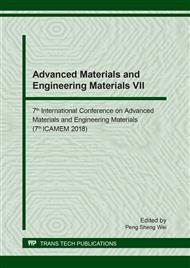p.339
p.344
p.350
p.356
p.361
p.366
p.372
p.377
p.381
Compression Test of Glass Fiber-Reinforced Ice
Abstract:
Lead or low temperature melting alloys have been sucessfuly utilized as a filling medium in tube forming processes, such as bending and bulging; however, strict lead-free-control plan in industries have prohibited the use of lead in recent years. The authors suggest the use of fiber-reinforced ice (FRI) as an alternative. Fiber of recycled paper was utilized for the preparation of FRIs, and the results of compression tests revealed that the fabricated FRIs exhibit sufficient crushing-strength suitable for use as an alternative for lead-filled media. However, the high density of the fiber in the mixture of fiber and water makes it difficult to fill a tube with the fiber in the pre-freezing process owing to its high vscosity. Therefore, it is useful to examine other strong fibers for FRIs to reduce the ratio of the fiber. In this study, the authors examined glass fibers as reinforcement in FRIs. Compression tests were conducted at various crosshead speeds, and the difference in the stress-strain behaviors of the FRIs with glass fiber and paper-pulp fiber was analyzed.
Info:
Periodical:
Pages:
361-365
Citation:
Online since:
August 2018
Authors:
Keywords:
Price:
Сopyright:
© 2018 Trans Tech Publications Ltd. All Rights Reserved
Share:
Citation:


